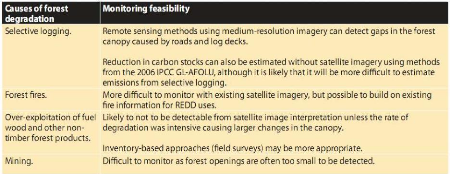2. Forest Degradation
2.1. Key concepts to forest degradation
Martin et al.( 2009) developed a way for understanding forest
degradation as followed, common indicators for monitoring and assessing forest
degradation can be developed for the following key elements to be used in
assessing forest degradation :
· Biodiversity (e.g. species composition and richness,
habitat fragmentation);
9
· Biomass (e.g. growing stock, forest structure);
· Forest goods obtained (compared against sustainably
managed forests);
· Forest health (e.g. fire, pest and diseases, invasive and
alien species);
· Soil quality (as indicated by cover, depth and
fertility).
For Simula (2009) terms degradation is a change process within
the forest, which negatively affects the characteristics of the forest. The
combination of various forest characteristics (forest quality) can be expressed
as the structure or function, which determines the capacity to supply forest
products and services (IPCC, 2003). Forests may be degraded in terms of loss of
any of the goods and services that they provide wood, food, habitat, water,
carbon storage and other protective socio-economic and cultural values
(Guariguata, 2009).
According to FAO (2002) degradation is typically caused by
disturbances, which vary in terms of the extent, severity, quality, origin and
frequency. The change process can be natural (caused by fire, storm, drought,
pest, disease) or it can be human induced (unsustainable logging, excessive
fuelwood collection, shifting cultivation, unsustainable hunting,
overgrazing).
Perceptions regarding forest degradation are many and varied,
depending on the driver of degradation and the main point of interest (Souza,
2005). In relation to REDD it is likely to entail a reduction in the capacity
to sequester carbon, but a forest may also be degraded in terms of loss of
biological diversity, forest health, productive or protective potential or
aesthetic value.
Forest degradation is generically defined as the reduced
capacity of a forest to provide goods and services (FAO, 2002). However, in the
context of climate change, the International panel on climate change IPCC
(2003) developed a definition of forest degradation that focuses on
human-induced changes in the carbon cycle in the long run:
A direct human-induced long-term loss (persisting for X years
or more) of at least Y% of forest carbon stocks [and forest values] since time
T and not qualifying as deforestation or an elected activity under Article 3.4
of the Kyoto Protocol, (ITTO, 2005).
2.2. Main causes of forest degradation
Many natural factors and human activities can affect forest
health and vitality leading to a gradual or sudden decrease in forest growth,
tree mortality and to a decline in the provision of forest goods and services.
For Fargan et al. (2009), Wild or human-induced fires, pollution, floods,
nutrients and extreme weather conditions such as storms, hurricanes, droughts,
snow, frost, wind and sun are among abiotic agents that may be responsible for
a loss of health and vigor of forest ecosystems. Biotic influences of forest
conditions include insect pests, diseases
10
and invasive species and can either consist of fungi, plants,
animal or bacteria. Humans are also a major factor of forest health
deterioration as overexploitation, competing land uses, poor harvesting
techniques or management can negatively impact forest ecosystems.
In the study of Herold et al. (2009), Forest degradation can
have any number of causes, dependent on resource condition, environmental
factors, socio-economic and demographic pressure and incidents for example
pests, disease, fire, and natural disasters. The understanding and separation
of different degradation processes is important for the definition of suitable
methods for measuring and monitoring. Various types of degradation will have
different effects on the forest storage carbon and result in different types of
indicators that can be used for monitoring degradation using in situ
and remote methods (i.e. trees being removed, canopy damaged etc.).

Table 2: causes of degradation and impacts on monitoring (adapted
from GOFC-GOLD, 2008)
| 


